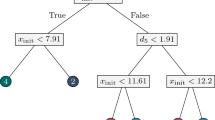Abstract
We consider the problem of determining a hyperplane that separates, as “well” as possible, two finite sets of points inR n. We analyze two criteria for judging the quality of a candidate hyperplane (i) the maximal distance of a misclassified point to the hyperplane (ii) the number of misclassified points. In each case, we investigate the computational complexity of the corresponding mathematical programs, give equivalent formulations, suggest solution algorithms and present preliminary numerical results.
Similar content being viewed by others
References
Bajgier SM and Hill AV (1982) An experimental comparison of statistical and linear programming approaches to the discriminant problem.Decision Sciences 13:604–618
Bodlaender HL, Gritzmann P, Klee V and Van Leeuwen J (1990) Computational complexity of norm-maximization.Combinatorica 10:203–225
Cavalier TM, Ignizio JP and Soyster AL (1989) Discriminant analysis via mathematical programming: certain problems and their causes.Computers and Operations Research 16:353–362
Fisher RA (1936) The use of multiple measurements in taxonomic problems.Annals of Eugenics 7:179–188
Freed N and Glover F (1981) A linear programming approach to the discriminant problem.Decision Sciences 12:68–74
Freed N and Glover F (1981) Simple but powerful goal programming models for discriminant problems.European Journal of Operational Research 7:44–60
Freund RM and Orlin JB (1985) On the complexity of four polyhedral set containment problems.Mathematical Programming 33:139–145
Garey MR and Johnson DS (1979)Computers and intactability, Freeman WH, San Francisco
Gaither N and Glorfeld W (1982) On using linear programming in discriminant problems.Decision Sciences 13:167–171
Glover F (1990) Improved linear programming models for discriminant analysis.Decision Sciences 21:771–785
Hansen P, Jaumard B and Savard G (1990) New branch- and-bound rules for linear bilevel programming, Cahier du GERAD G-89-09. Ecole Polytechnique, Montréal, submitted for publication
Horst R and Tuy H (1990) Global optimization. Deterministic approaches. Springer-Verlag, New-York
Johnson DS and Preparata FP (1978) The densest hemisphere problem.Theoretical Computer Science 6:93–107
Kojima M, Mizuno S and Noma T. A polynomial-time algorithm for a class of linear complementarity problems, to appear inMathematical Programming
Khachyan LG (1979) A polynomial algorithm in linear programming (in Russian),Doklady Akademiia Nauk SSSR 244:1093–1096; English translation:Soviet Mathematics Doklady 20:191–194
Koehler GJ (1989) Characterization of unacceptable solutions in LP discriminant analysis.Decision Sciences 20:239–257
Koehler GJ and Erenguc SS (1990) Minimizing misclassifications in linear discriminant analysis.Decision Sciences 21:63–85
Konno H (1976) Maximization of a convex quadratic function subject to linear constraints.Mathematical Programming 11:117–127
Lin YY and Pang JS (1987) Iterative methods for large convex quadratic programs: a survey.SIAM Journal on Control and Optimization 25:383–411
Markowski CA and Markowski EP (1987) An experimental comparison of several approaches to the discriminant problem with both qualitative and quantitative variables.European Journal of Operational Research 28:74–78
Rubin PA (1989) Evaluating the maximize minimum distance formulation of the linear discriminant problem.European Journal of Operational Research 41:240–248
Stam A and Joachimsthaler EA (1990) A comparison of a robust mixed-integer approach to existing methods for establishing classification rules for the discriminant problem.European Journal of Operational Research 46:113–122
Wolfe P (1976) Finding the nearest point in a polytope.Mathematical Programming 11:128–149
Author information
Authors and Affiliations
Additional information
Research supported by NSERC grants 5789 and 46405, the Academic Research Program of the Department of National Defense (Canada) and FCAR grant 91NC0510. (Québec).
Rights and permissions
About this article
Cite this article
Marcotte, P., Savard, G. Novel approaches to the discrimination problem. ZOR - Methods and Models of Operations Research 36, 517–545 (1992). https://doi.org/10.1007/BF01416243
Received:
Revised:
Issue Date:
DOI: https://doi.org/10.1007/BF01416243



